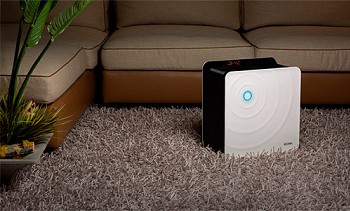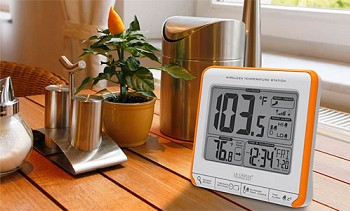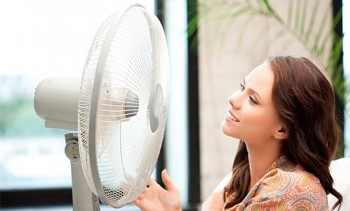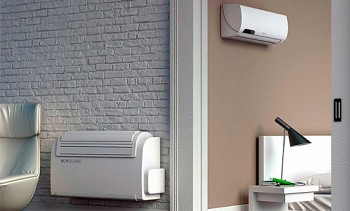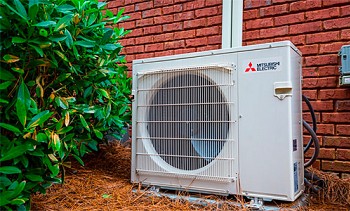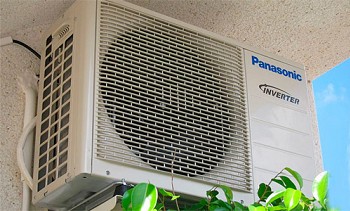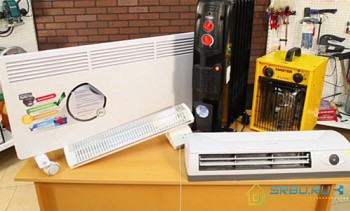From this article you will learn how to choose a mobile air conditioner and what features of the climate technology you need to pay attention to before buying. After reading a detailed description of the design features and operating modes, you will learn to understand the features of mobile air conditioning systems and will be able to choose the best model.
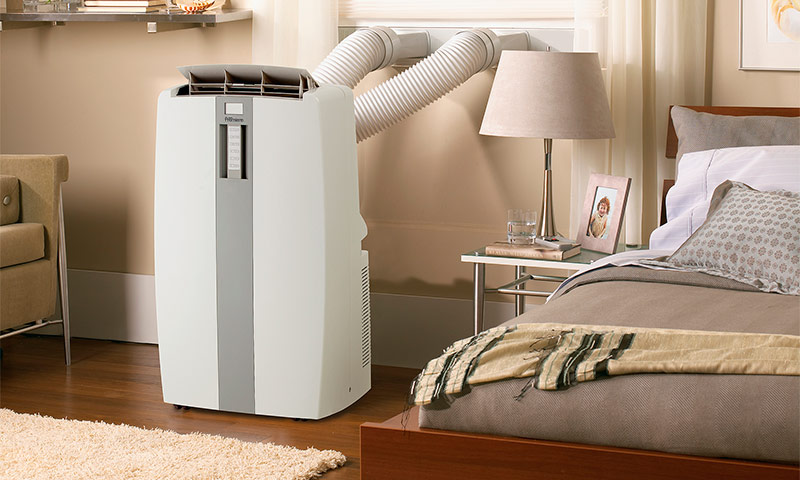
Content:
- Varieties and design of mobile air conditioners
- What modes of operation may be present in a mobile air conditioner
- How to calculate the power of a mobile air conditioner
- How do inverter mobile air conditioners differ from conventional
- Mobile Air Conditioner Management Systems
- Device dimensions
- Additional features that may come in handy.
- Advantages and disadvantages of mobile air conditioners in comparison with split systems
Varieties and design of mobile air conditioners
By design, mobile climate devices are of two types:
Mobile candy bar.
Mobile split system.
Mobile candy bar
The first variety is similar to a window air conditioner, but there is a difference: the units in the mobile candy bar are located vertically, not horizontally. The ventilation mechanism and the evaporator are located in the upper compartment, and the lower compartment is occupied by a condenser, compressor and a fan that removes heat. The compartments are separated by a metal partition.
In the upper section of the air conditioner there is an air intake through which air flows from the room. Filtered and cooled air is returned to the room through openings provided with guide louvers.
In order to cool the condenser, air enters the bottom of the device from the rear. There, it is heated by a condenser and discharged into the street through an air outlet, which must be discharged either through a special hole or through a window. The corrugated air outlet looks like a vacuum cleaner hose, its diameter is 15 cm and its length is 1.5 m.

In a wide variety of monoblocks, there are models capable of processing only the internal atmosphere in the room, and models that supply the room with air from the street. In the second case, the air conditioner has two corrugated hoses: fresh air enters one by one, and the heated air is discharged into the street through the second hose.

During the operation of the mobile air conditioning system, condensation forms. It accumulates in a 4–5 liter capacity container located at the bottom of the device. For normal operation of the compressor, it is necessary to periodically pour out the accumulated liquid.
When the hose is led out through a slit of an ajar sash or balcony door for temporary installation, a leak of cooled air is possible. Therefore, this method is not the most convenient and uneconomical.

Included with some air conditioners is an air lock, which allows the hoses to be routed through the casement window without forming a gap. An air lock can be purchased separately. It is suitable for different designs of swing windows.
Application of an air lock for air exhaust:


“Slitless” laying of communications is suitable for fixed installation. Individual monoblock models are equipped with special plugs that can be installed in the frame of the sliding window from the bottom or side. The length of this optional part is adjustable to fit exactly the size of the window. The hose is held in the hole in the plug itself.

An alternative way to withdraw communications is through a hole cut into the glass or punched into the wall. Fittings are installed in such holes so that it is more convenient to remove the hose. After dismantling the climate technology, the "vents" are closed with plugs.
Mobile split system
Such an air conditioner consists of two units: internal and external. Unlike a conventional split air conditioner, the mobile system has a slightly different device: the compressor is located in the indoor unit. In this unit, installed inside the room, there is a refrigeration unit, and in an external unit located outside the room, there is a condenser and a fan. For ease of transportation, both parts of the mobile device are equipped with small wheels. The blocks are connected using freon wires and electrical wiring. All communications are protected by a single outer shell. The length of such a hose reaches 2-3 m.
If temporary installation of a mobile split system is required, the external element is placed in the utility room or fixed to the window. As a fastening, use screws screwed into the wall, or slings fixed to the heating radiator. For ease of installation on the facade of the building, some models are equipped with special brackets. The installation of such devices requires the help of industrial climbers.

Temporary installation of a split air conditioner involves laying communications through a window (fully open or through the gap between the sash and frame). If the house has windows with wooden frames and glazing on glazing beads, you can cut a groove in the lower part of the frame and pass a hose through it. In addition, there are special plugs that are inserted between the sliding window frames and allow communication between the two units. Then you can completely close the window without damaging the communication.

The most difficult option: laying inter-unit hoses through a hole in the outer wall. The diameter of the hole should be about 8–12 cm. In this case, the blocks will need to be disconnected, which is only possible when self-sealing flanges are installed on the indoor unit. This complex procedure should be performed at a service center.
What modes of operation may be present in a mobile air conditioner
The list of functions built into modern climate technology can be varied:
- cooling mode;
- heat;
- drainage of air;
- ventilation;
- cleaning up.
With regard to mobile air conditioners, there are some limitations - these devices can not always be used under any conditions. It is recommended in advance, even before purchasing the device, to learn about all the features and operating modes.
Cooling mode
Air cooling is the main operating mode of the air conditioner, which is present in all models. It is used only in the summer, because in winter there is no need to artificially cool the room - it is easier and more economical to get cold air through an ajar window.
To lower the air temperature in monoblocks, the capabilities of a vapor compression refrigeration machine are used. This device is similar to units installed in conventional refrigerators. Manufacturers recommend turning on the air conditioner at a temperature of 17 to 30 ° C. Less often, the boundaries of the operating range are slightly wider - from 16 to 35 ° C. If the room temperature significantly exceeds the specified limits, then the device will malfunction and you will not be able to get the desired effect from the device. Failure due to violation of the rules of use is not a warranty case, so you will have to repair the device at your own expense.
If the temperature in the room drops to the value you set, the air conditioner turns off the cooling. After that, the device goes into ventilation mode. The cooling mode will be automatically activated when the temperature in the room exceeds the set value.
Heating mode
In Russian conditions, the heating mode may be required at any time of the year. Mobile devices successfully cope with space heating, not inferior to fan heaters and oil radiators. Moreover, they can be operated year-round.
For air heating, mobile air conditioners can be equipped with electric heaters (most often) or produce heating while working in the heat pump mode, as is done in stationary split systems.
Built-in electric heaters, which mobile air conditioners use to heat the air, work great at any temperature. Heaters are heating elements made of steel or a heating coil. This design is durable, reliable and unpretentious.

There are models of air conditioners that heat air in the heat pump mode, that is, in the process of reversing the refrigeration cycle. In this case, excess cold is removed through the hose from the room. This economical heating method can be used at temperatures between 5 and 21 ° C. For the operation of such devices in winter or autumn, a “gapless” installation of climate control equipment will be required. If you remove the hose in an ajar window, then because of the draft, the power of the air conditioner may not be enough for heating.
How quickly the desired temperature is reached depends on the fan speed. Typically, mobile air conditioning systems have three speeds:
- high;
- average;
- low.
Microprocessor-controlled devices operate in automatic mode. It is enough to indicate the desired temperature, and the microprocessor will analyze the actual and set values, choosing the desired operating mode: cooling, heating or ventilation without heat treatment.
Dehumidification mode
All mobile monoblocks offered in the market of climatic equipment are able to lower air humidity. Drainage is useful in cases where it is necessary to avoid the appearance of condensation on walls and ceilings so that the wallpaper does not fade and the paint does not crack. If you turn on the air conditioner in the room where the laundry is dried after washing, the textile products will dry in a matter of hours, even during rain and excessive humidity. It is useful to dry the air using mobile systems in pantries with food supplies: this allows you to protect bulk products such as flour, sugar, salt from moisture and spoilage.
The air is drained in cooling mode. But most of the models are equipped with a special function - removing moisture from the air without lowering the temperature in the room. In this case, the fan speed is automatically controlled. For maximum drainage efficiency, doors and windows should be tightly closed.
In this mode, the surfaces of the evaporative heat exchanger are cooled to a temperature of 3 ° C. The air circulating in the air conditioner contacts the cold plates and moisture condenses on them. Further, condensate can be removed in various ways. Some models of air conditioning systems do not have a water tank, in them moisture immediately enters the heated condenser, turns into steam and is removed through the hose outside the room. In such a system, the refrigeration cycle is the most efficient. In other models of mobile devices, there is a tank in which condensate accumulates. With high humidity, the tank is filled with water for 2-3 hours, after which the compressor stops working. This means that the accumulated water must be emptied from the tank.
If a device equipped with a tank is used in one place, then it is more profitable to create a stationary water drainage system. To do this, a hose is connected to the drain pipe of the air conditioner, which is connected to the sewer. Sewer drain should be below the drain pipe. After that, there is no need to control the tank filling level: the device does not turn off, since there is no overfilling, and you can forget about the procedure for emptying the tank. If the air conditioner is additionally equipped with a pump, then the accumulated water can rise to a height of 4 m and above. This allows the use of mobile candy bars to reduce humidity in the basement of private homes.
Air purification mode
The filtering function of mobile air conditioning systems is still not sufficiently developed, compared with stationary split air conditioners. However, all mobile devices have air filters. The design of the filter element consists of a plastic frame with a fine polymer mesh. Filters need periodic maintenance - they must be washed with water. Use of a neutral detergent is acceptable.

When installing the appliance temporarily, the hose should be led into a slightly open window. Stationary installation means the output into the hole in the glass.
For additional fine cleaning, you can equip the existing filter with a special insert made on the basis of materials with electrostatic properties or using activated carbon. After a year, these inserts should be replaced with new ones, because it is impossible to clean or restore them.
Some models of mobile climatic equipment are equipped with built-in filters for cleaning from fine impurities. There are also devices with a unipolar ionizer. They allow you to clean the air from suspended particles, giving them a negative charge so that these particles settle on the floor or walls that have a positive charge. Negative ions in small quantities are useful for humans: they create a surge of strength and a sense of vigor.
How to calculate the power of a mobile air conditioner
Before choosing a floor air conditioner for an apartment, it is necessary to correctly calculate the cooling capacity, or the power of the air conditioning system. It should be sufficient to cool the entire room.
It should be borne in mind:
- volume of the room;
- number and size of window openings;
- the location of the windows relative to the cardinal points;
- the presence in the room of a refrigerator, computer, TV, stove and other equipment.
The easiest way to calculate the required power is to simply measure the area of the room (in m2) and divide it by 10. The resulting number will mean the required power (in kW).
For more accurate calculations, use the approximate formula:
P = SHq + Q1,
1. where P is the power of the air conditioner required to cool the room, W;
2. S - room area, m2;
3. H - ceiling height in the room, m;
4. q - "solar" coefficient, which is determined depending on the degree of illumination of the room by the sun. It has the following meanings:
q = 30 W / m3 for rooms on the north side, where there is little sunlight;
q = 35 W / m3 for rooms with a normal level of lighting;
q = 40 W / m3 for rooms located on the south side, as well as for rooms with a large glazing area;
5. Q1 - the sum of heat from additional sources (equipment and people). The average heat transfer from a person is 120-130 W / h. From the computer, an additional 300-400 W / h is received, and for a TV this value reaches 700 W / h.
In addition to the usual measurement of power in watts, there is another unit - BTU, or British thermal unit. It is sometimes used in promotional materials.
In order to convert a value from one unit of measurement to another, you need to use the ratio:
1 BTU = 0.2931 watts.
How do inverter mobile air conditioners differ from conventional
In conventional air conditioning systems, there are two modes of compressor operation: “on” and “off”. This reduces their service life. In devices with a frequency converter - inverter - the compressor works without shutting down. The engine speed changes smoothly, so the cooling power is regulated just as smoothly.
You can clearly see the differences between inverter and non-inverter air conditioners in the video clip:
Before you buy an inverter unit, you should learn about the pros and cons of this type of mobile air conditioner. The main advantages of such devices:
- inverter systems more accurately maintain a given temperature;
- noise level is lower than from conventional air conditioners;
- electricity consumption reduced by 30–35%.
However, devices of this type can not always be operated outside the city: minus the inverter - sensitivity to the stability of the supply voltage. In order for the equipment to last for a long time, you need to buy a reliable voltage regulator. Currently, there are not many inverter mobile models on the market.
Mobile Air Conditioner Management Systems
The simplest mobile systems are equipped with electromechanical control devices - buttons and knobs for temperature control. Many people like the simplicity and convenience of such models, because there is nothing superfluous in the control system and the climate control in the room is simple.

However, the cheapest air conditioners of this type do not have protection against frequent starts, that is, there is no delay for 3 minutes. Frequent starts can lead to engine malfunctions and equipment failure. When turning off such devices, make sure that the mobile air conditioner does not turn on on its own. Mechanically controlled devices are uneconomical.
If the unit is equipped with an electronic system, then it can be controlled using the remote control from a distance not exceeding 8 m. The advantage of such monoblocks is more accurate temperature control in the room. There is also an additional option - setting the operation of the device according to a timer (24-hour or 12-hour). If you wish, you can set the program so that the device turns off after 2 hours, when you are already sleeping. Or, conversely, set the air conditioner so that it turns on half an hour before you return home. So by your arrival, the temperature in the living room, bedroom or kitchen will be comfortable.
Climatic equipment with an electronic control system not only looks more modern and perfect, but also allows you to save electricity. A big plus of such devices is the presence of built-in protection against misuse.

Before buying an electronically controlled air conditioner, you should carefully study the capabilities of the remote control. On some models, the remote control has limited functionality, so you will have to approach the device to select certain modes or functions. There are also such air conditioning systems in which all the functionality presented on the control panel on the device body is duplicated on the remote control.

Also, a temperature sensor can be integrated into the remote control. This is convenient, because when the exact temperature is known, it is easier to set up the air conditioner from anywhere in the room. When you set the necessary temperature indicators, it takes only a few minutes for the air conditioning system to create optimal comfortable conditions in your home.
Device dimensions
The mobile climate system is installed on the floor, so it is necessary that the device fits into the space reserved for it. Before choosing a floor air conditioner, you need to decide in advance where you will install it. It is recommended to measure the space taking into account the fact that between the wall and the equipment you need to leave 30 cm, and the hose length will be about 5 m. This will allow you to imagine in the imagination which device fits into this place, what dimensions and shape it should have.
Additional features that may come in handy.
Automatic maintenance of temperature.
A device equipped with this function can automatically maintain the set temperature. To do this, the air conditioner analyzes the current temperature and switches to the desired mode: cooling, ventilation or heating. Also, the device can change the fan speed and air flow direction.

Night mode.
In this mode, the equipment works with minimal noise. In this case, the fan speed decreases to the lowest values, and the temperature gradually decreases by 2-3 degrees (if the cooling mode is on) or increases (when the heating mode is activated).

Fine filters.
If the apparatus is equipped with such filters, particles up to 0.01 microns in size are removed from the air. The air in the room is cleaned of microorganisms and pollen.

Auto restart.
In cases when there is a power failure or the operation cycle is completed, the air conditioner will automatically restore the previous operation mode.

On and off timer.
This convenient function is useful in order to prepare the room for your return or turn off the device when you fall asleep.

Airflow direction adjustment.
Air conditioners with this function allow you to choose the flow direction so that the air is blown in the right direction. To do this, built-in guides are used, which can be rotated up or down, left or right.

Display.
A convenient addition is the display on the indoor unit. It displays information about temperature, humidity, set mode and other information.

Advantages and disadvantages of mobile air conditioners in comparison with split systems
The main advantage of mobile air conditioning systems is mobility itself. However, they also have other advantages over widespread stationary split systems.
1. Mobile devices are designed, manufactured, filled with freon and tested in the factory, so when used correctly, they are reliable and reliable, like conventional refrigerators. A stationary split system must be installed at the facility, so it is difficult to achieve good tightness of the structure. As a result, the unit needs regular refueling with freon (approximately once a year or in 2 years). This requires inviting a specialist from the service center and each time paying for the service from 800 to 5000 rubles.

2. After installing the mobile device, the appearance of the facade of the building does not deteriorate - only a small hole will be visible. This allows the use of such air conditioners when it is impossible to place the outdoor unit of the air conditioning system on the facade (for example, in the historic city center). Everyone who installs a split system should be aware that at any time the city authorities may demand to remove outdoor units that spoil the appearance of the facade. Such a case has already happened in the Czech Republic, in the city of Prague. In addition, the presence of the exterior of the air conditioner on the facade reduces the safety of housing at a time when the owners are not at home.
3. Modern industry has not yet switched to the production of only mobile units and has not refused to produce other types of air conditioners due to the main drawback of “mobile phones” - their excessive noise. The design features of mobile air conditioners do not allow them to be as silent as stationary counterparts. The reason is that the most noisy element of the mobile unit - the compressor - is located indoors.
Manufacturers are looking for an opportunity to reduce the noise level from these devices. Most models from other manufacturers have a minimum noise level of 45-50 dB. With such a noise level, it is quite difficult even for urban residents, who are accustomed to constant noise, to sleep in a country house in nature on a summer night under such a “roar” is extremely difficult.
4. Mobile climate technology takes up a lot of space, which is especially noticeable in small rooms. You can move the device relative to the window opening, but only to the extent limited by the length of the hose.

5. The disadvantages include problems with air distribution: chilled air, pumped through the grill in the upper part of the device, sometimes blows in the legs. In addition, if during installation of a mobile air conditioner there is a gap in the window, mosquitoes and other insects penetrate the room through it.

